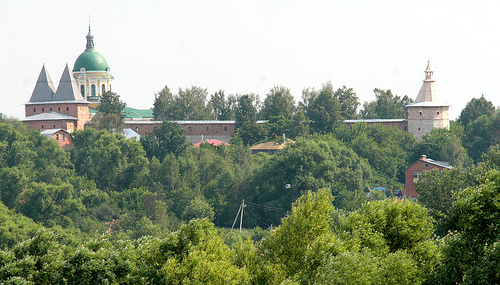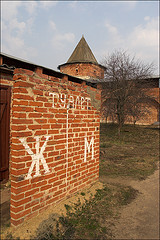

Location: Zaraysk
Constructed: 1528- 31

Public Washroom Russian style. "M" stands for "men, "Ж" stands for "women"
Zaraysk Kremlin is a modest medieval fortress not far from
Moscow. It is one of the few such fortifications that were preserved
in its original appearance. Zaraysk Kremlin in Zaraysk was erected
in 1528- 31 on the order of Grand Prince Vasily the Dark or the
Blind. The citadel has rectangular layout with four towers with
twelfth angles and three square towers that also served as a gate.
These numbers are not chosen accidentally. They all are also
repeated in number of domes on Russian Orthodox Churches. Twelfth
stands for twelfth apostles of Jesus Christ, four is number of
gospels in the New Testament and three is a Trinity of Father, Son,
and Holy Ghost. The North- East corner tower was indented for
storage of guns, gunpowder and ammunition.
Museum is located
on the grounds of the castle that displays a collection of
paintings, drawings, crafts, sculpture and decorative arts of
Russian and Western Europe.
In 1681 Zaraysk Castle receives a Cathedral of Saint Nicholas. The order for its construction is given by Tsar Fedor Alekseevich and its chief designers becomes Peter Liubavskii. It kept a miracle working icon of Saint Nicholas of Zaraisk that originally was moved here from Korsun in 1225. After the Soviet Revolution the church was looted by the atheist government. Today the icon is kept in a Museum of Old Russian Art in Moscow. The church contains iconostasis of XVIII century.
The Church of Saint John the Baptist was built in 1821. In 1904 the church got a facelift with addition of exterior decorations.
By decree of Vasily III, a Kremlin was
erected in the village of Novogorodok-on-Sturgeon in 1528-1531.
Already in 1533 the Kremlin underwent the first attack by the
Kazan Tatars. In 1528, the wooden St. Nicholas Church was replaced
by a stone one, and the city began to be called the city of St.
Nicholas Zarazsky on the Sturgeon. In 1541, the Kremlin was besieged
by the Crimean Khan Sahib I Girey, who could not take the city and
was defeated by the voivode Nazariy Glebov. Crimeans also attacked
the city in 1544, 1570, 1573, 1591.
In the 17th century, the
city began to be called Zaraisk. Since the end of the 17th century,
the Kremlin has lost its defensive significance. In 1681, by decree
of Tsar Fyodor Alekseevich, a brick St. Nicholas Church was built
inside the Kremlin instead of a dilapidated stone one.
Now on
the territory of the Kremlin there is a museum "Zaraisk Kremlin".
The stone Kremlin, built in 1528-1531,
covers an area of 134 × 190 m, rectangular in plan. The Kremlin
has 7 powerful towers, of which 3 are with gates. The fourth
(Trinity - in the eastern wall) gate was pierced in 1789.
Nikolsky Cathedral (1681).
John the Baptist Cathedral (1904).
The building of the Zaraisk theological school (1864).